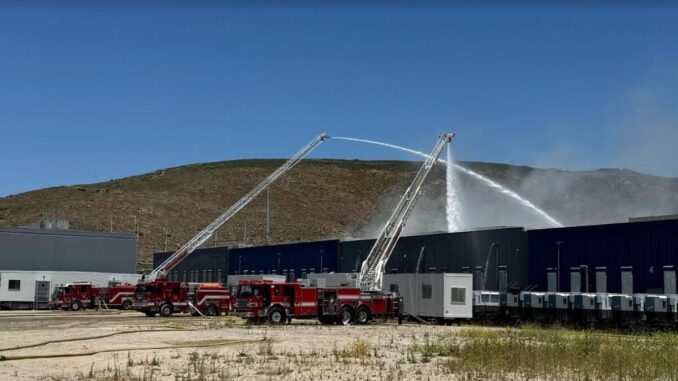
OTAY MESA — The long-smoldering battery plant fire in Otay Mesa neared the four-day mark Sunday with no indication that full containment was imminent.
Cal Fire Capt. Brent Pascua said mid-morning that the situation continued roughly as it was Saturday night with 40 firefighters and five engines assigned .
“We still have light wispy smoke coming from the fire,” Pascua said. “Our goal is to continue to keep it contained to the building it started in.”
There was no firm estimate of how much longer the fire might continue.
“Speaking with the experts, in the past they’re had a few incidents like this, and it’s anywhere from seven days to a couple of weeks,” Pascua said.
A stubborn fire at an energy storage facility in Otay Mesa reignited late Friday night and continued well into Saturday, as about 40 firefighters poured water into the location in the hopes of finally extinguishing the blaze.
At 8:23 p.m. Friday, Pascua said, a “significant fire” reignited inside one of the buildings at the Gateway Energy Storage Facility on Camino De La Fuente — the result of a chain reaction called “thermal runaway” that can occur when lithium-ion batteries overheat.
“The fire did get into the structure itself and that is now on fire and firefighters continue to pour water on it as we speak,” Pascua said at 12:45 p.m. Saturday.
Evacuation orders and warnings are in effect in the immediate vicinity of the facility, an area that includes several businesses. However, the orders could be expanded if, say, the wind shifts, increasing the potential threat of the fire.
“If that happens, we’ll start the evacuation warnings early so people can be informed and be aware,” Pascua said, “but we’re hopeful that’s not going to happen.”
A San Diego County hazardous materials team is on-site monitoring air quality, and on Saturday afternoon readings were normal.
Fire was first discovered at the 250-megawatt storage facility on Wednesday afternoon. Evacuation warnings for surrounding businesses were issued and a shelter-in-place order was considered at the nearby Donovan state prison because of fears of toxic fumes and potential explosions. State officials said Friday, however, that operations at the prison were not impacted.
Crews pumped water from a hydrant into the building’s fire-suppression system that drenched the batteries, leaving the blaze almost entirely extinguished by Thursday afternoon.
A few batteries reignited Thursday night, but by Friday crews had ventilated the area where the fire was centered and one fire official described the situation as being “relatively under control.”
But after some batteries flared again Friday night, more than three dozen firefighters were back at work battling the blaze.
Rev Renewables, a subsidiary of LS Power that owns and operates the Gateway facility, confirmed in an email that the fire had reignited.
“While unfortunate, this development was not unexpected,” Rev Renewables said in an email, “as these kinds of fires can reignite and take time to be fully extinguished. We remain in close coordination with local first responders and will provide updates as this situation develops.”
The Gateway facility uses lithium-ion batteries that provide electricity to the state’s power grid.
Energy storage projects have taken on a higher profile in recent years as more renewable sources of power have come onto California’s electric system.
Storage facilities typically take in solar power generated during the day and discharge the electricity later, especially from 4 to 9 p.m. when California’s grid is under the most stress. Batteries can help reduce the risk of rotating power outages and replace natural gas “peaker plants” used during those critical hours when customers crank up their air conditioners.
Boosting energy storage is crucial for California to reach its target of deriving 100 percent of electricity from carbon-free sources by 2045.
But there have been instances in which excessive heat inside a battery leads to a chemical reaction that spreads to other batteries in a thermal runaway event.
“Historically speaking, we usually tend to see a much longer period of time where this cascading damage just keeps going, almost like the domino effect,” Robert Rezende, battalion chief and the Alternative Energy Emergency Response coordinator for the San Diego Fire-Rescue Department, said Friday.
Saturday’s flare-up burned through the roof of the building where the Gateway fire is located.
Pascua said fire officials can’t predict how long it will take for the batteries to stop reigniting.
“We’re just doing our best with what we have in front of us and to keep it contained,” he said.
Source: Sandiegouniontribune.com






